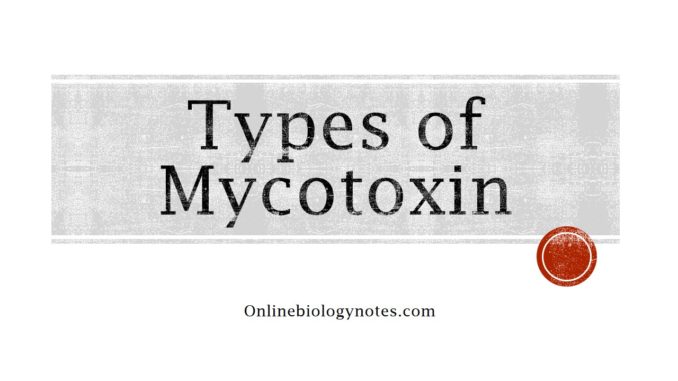
Mycotoxins:
- Mycotoxins are toxic chemical produced by some pathogenic strain of fungi.
- Many strains of fungi contaminate the food and produce potent mycotoxin in food.
- Disease resulting from ingestion of mycotoxin in food is called mycotoxicosis. E.g. mushroom poisoning.
- One important characteristic of most mycotoxin is that they are heat stable.
- Therefore, if mycotoxin is produced in food, it is not damaged easily during normal cooking of food.
- Most of the mycotoxin cause mutation and are associated with various types of cancer.
- Mycotoxins are secondary metabolites of fungi.
- Metabolites produced by microorganisms are divided into two types i.e. primary and secondary metabolites.
- Metabolites produced by certain microorganisms that serve as a growth factor for other microorganisms are called as primary metabolites. E.g. vitamins, amino-acids, carbohydrate etc.
- Primary metabolites are produced during log phase.
- Metabolites produced by certain microorganisms which are not needed for growth if other organisms are called secondary metabolites. E.g. toxin, antibiotic etc.
- Secondary metabolites are produced during stationary phage of growth.
Types of mycotoxin:
1. Aflatoxin:
- It is produced by Aspergillus flavus, A. parasiticus and some Penicillium spp.
- It is located from variety of mold contaminated food like peanuts, rice etc.
- Two major types of toxin include B1 and G1 that show blue and green fluorescence when exposed to UV lights.
- Other types of aflatoxin include B2, G2, M1, M2, and P1 which are derivatives of B1 and G1.
- Among them B1 is most toxic.
- After ingestion, aflatoxin binds to chromosomal DNA and causes point mutation and frame-shift mutation.
- By inducing mutation, they cause cancer of liver.
- Aflatoxin is toxic to wide variety of animals like cat, chicken, cattle, human beings etc.
2. Patulin:
- It is produced by wide variety of mold including Penicillium expansum, P. patulum, P. melini, P. equinum, Aspergillus clavatus, A. terreus etc.
- It is isolated from many molds contaminated food like bread, sausages, fruits etc.
- It is white crystalline solid.
- It is sensitive to SO2 and alkali but resistant to acid.
- Patulin binds to NH2 and -SH functional group of biomolecules and causes chromosomal aberration.
- It affects wide variety of animals and plants as well as bacterial cells like E. coli and Staphylococcus aureus.
- Therefore, originally it was classified as antibiotics.
- Tissue damage caused by patulin include oedema of brain, hemorrhage of lungs, damage of blood capillary, spleen and kidney.
3. Penicillic acid:
- It is produced by Penicillium roqueforti, P. cyclopium, P. morteneii, Aspergillus flavus, A. ochraceus.
- It is isolated from many molds contaminated food like tobacco.
- Penicillic acid binds to –SH and –NH2 group of biomolecules forming covalent bond.
- It is carcinogenic and affects wide variety of animals including rat.
4. Citrinin:
- It is produced by Penicillium citrinum, P. viridicatum and other species.
- It is isolated from many mold contaminated foods like- polished rice, bread, meat and meat products
- It is carcinogenic to wide variety of animals.
5. Ochratoxin:
- There are atleast seven types of structurally related ochratoxin, of which type A is the most common and most toxic.
- It is produced by many Aspergillus and Penicillium species like- A. ochraceus, A. alliaceous, A. mellis, P. viridicatum, P. cycloplum.
- Like other mycotoxin, it is heat stable and is not damaged during cooking of food.
- When ochratoxin is ingested it induces mitosis and cause cancer of kidney.
6. Sterigmatocystin:
- It is produced by Aspergillus versicolor, A. nidulus, A. regulosus and other.
- It causes cancer of liver by inhibiting DNA synthesis.
